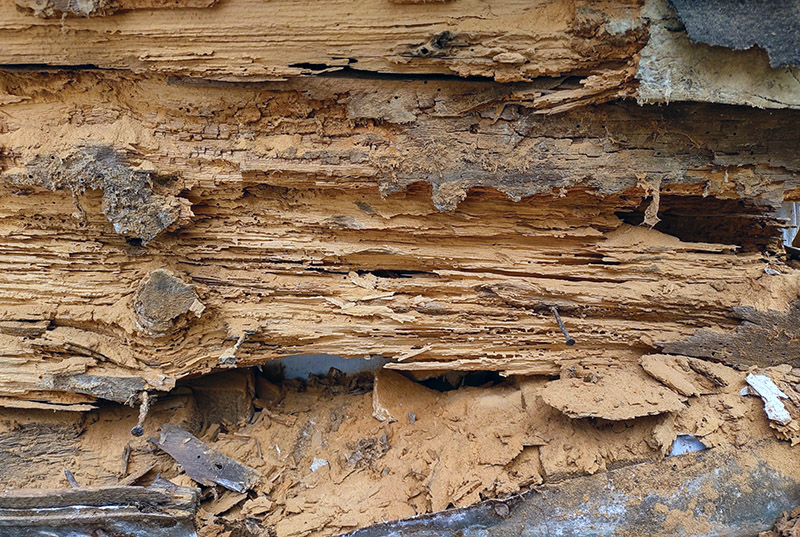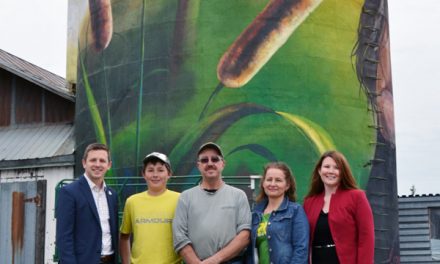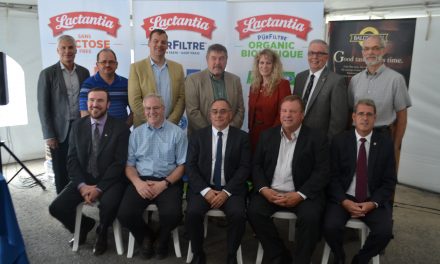Carpenter ants swarm in the spring, indicating that a colony is nesting close by. Photos of a winged ant and the structural damage in an external wall of a house in Ottawa. Al-Rajab Photo
If you observed some winged carpenter ants inside the structure in spring, that indicates a colony is nesting around somewhere. It’s a destructive pest tunnel through structural wood without any noticeable external damage. In some cases, homeowners may observe wood fragments and sawdust that fall through cracks the ants have created. Depending on the damage, repairs may cost a few thousand dollars.
Ants are important components of ecosystems. They have existed on earth for about 140 million years during the Jurassic period. There are more than 12,000 species of ants worldwide, and over 100 species in Canada, some of which are a structure-damaging species.
Carpenter ants are a common destructive pest known worldwide; they were named after their nest building capabilities inside of wood. These ants do not eat wood, they only chew through wood and make tunnels to create their nest; so, they are different from termites which eat wood as a source of cellulose, their main diet. Carpenter ants don’t sting; their bite can be painful because they spray the bites with formic acid, which compounds the pain.
The black carpenter ant (Camponotus pennsylvanicus) is the most common in Ontario and Quebec and it’s known for its big size from 6 to 12 mm. Ants are social insects and live only in colonies. A large colony may have over 50,000 individuals, about 10-20 per cent of which are workers. When foraging, ants leave a pheromone trail so that they know where they’ve already been. An ant can lift 20 times its own body weight. Each colony is controlled by only one wingless queen, which could live 15 years and lay more than 70,000 eggs. When the colony is established for more than two years, winged males and females (swarmers) are produced and leave the colony to mate and establish new colonies. Swarming usually occurs in the summer months in Ontario and Quebec from June until August.
Farming aphids
In the field, carpenter ants farm aphids by protecting them from predators (other insects) while they excrete a sugary fluid called honeydew, which the ants get by stroking the aphids with their antennae. Carpenter ants don’t cause direct harm to plants and can be beneficial when growing vegetables. However, the company they tend to keep can harm the garden. Carpenter ants feed on sources of protein and sugar such as insects and honeydew. While gathering food, they often unwittingly pollinate flowers. And because they build their nests from dead wood and leaves, they often carry away dead matter, allowing better air flow for growing vegetable matter. Further, ants often feed on insects that would otherwise harm the plants. Carpenter ants have a very important ecological role, they chew tons of decayed wood and turn sawdust that degraded and provide compost to new growth.
How to control carpenter ants?
In the field, carpenter ants are considered beneficial, and their presence is important for ecosystems. However, they are only considered destructive pests when they enter the structure. Once they are inside, carpenter ants eat any source of food available such as meat, pet food, sugar, honey, or other sweets. Carpenter ants build their colony preferably in decayed wood softened by fungus, which is associated with a moisture problem, or in standing trees (living or dead).
Eliminating an existing infestation of carpenter ants is a challenge. A professional pest control company must be able to help locate the nest and apply the proper treatment with baits or other chemicals depending on the situation.
Yet, prevention plays an important role in the integrated pest management program for carpenter ants. For example, a wood fireplace must be inspected before being brought inside. If any ants or tunnels are seen in the logs, they must be left outside. Also, the wood should be stored away from the structure’s foundation, and the structural wood should remain dry.













